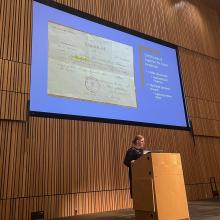Co-presented by the University of Washington's Department of Scandinavian Studies and the National Nordic Museum, the SCAND30 series is a popular, fascinating, and free series of short public lectures held at the National Nordic Museum in Ballard each month, on a wide array of topics. Sometimes our faculty members have the opportunity to present a lecture in the series, which has happened a couple of times so far this year.
On February 9th, Associate Professor Olivia Gunn delved into an element of Scandinavian family lore: the birth of children out of wedlock, which has been discouraged and at times criminalized by the Lutheran church and Norwegian state. Gunn traced the life of a certain Ingeborg, who first served a fisherman named Reinholdt as his domestic servant, then became mother to his children, and only afterward his wife. Such stories ,Gunn showed, were more common than one might think, and more a consequence of economics than so-called "loose morals." Gunn then demonstrated how stories like Ingeborg's have been used to frame narratives of moral "progress" and to promote ideologies of settler-colonialism in famous literature like Knut Hamsun's /Growth of the Soil/. Gunn warned against the dangers of such narratives and of uncritically encountering and repeating them, either in the literature we read or the stories we tell about our own families.
And at the beginning of March, Professor Marianne Stecher-Hansen illuminated the history of the Nazi German occupation of Denmark in WWII through the story of her late father, who was a soldier and member of the underground Danish resistance.
“What do we do with our old things? Why do we keep them?” Marianne asked. “Keeping and caring for things that once belonged to family or friends is a form of grieving.”
Objects are their own form of memory, and Marianne told her father’s story through objects left behind, some personal, some collective: his military training manuals, his soldier’s songbook, and his own well-worn “freedom fighter” armband, as well as archival images of propaganda posters and underground literature.
When Denmark was liberated on 5 May 1945, active resistance members of the Danish Brigade (5,000 Danish soldiers who had trained in neutral Sweden) were issued armbands to identify them as armed combatants and not civilians or guerilla fighters. Tens of thousands of Danes contributed to the active resistance in military or organized underground groups, and many hundreds of thousands contributed to non-violent resistance and civil disobedience.
The United States Holocaust Memorial Museum describes one armband: “Rectangular, blue wool armband with a horizontal red and white stripe. The red wool stripe is sewn across the center of the armband with blue thread and is divided by a narrow, white, cloth stripe stitched along the mid-line with white thread. The short ends of the band are hemmed and stitched together. The edges of the blue and red bands are unfinished.”
As fewer and fewer survivors of WWII remain alive today, personal and communicative memories fade into collective memories. Scholarship is one way individual stories can shape and reshape historical narratives, and this work is forever unfinished, just as the blue and red edges of the freedom fighter armband. Analysis of the cultural memory of WWII in the Nordic Region may be found in Marianne Stecher-Hansen’s recently edited volume Nordic War Stories.
These 30-minute Scand30 talks are superb, you won’t want to miss the next one!
